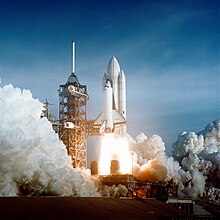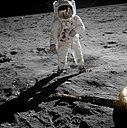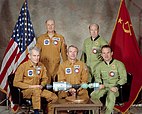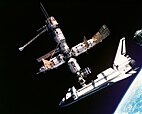
Space Race
US–USSR spaceflight capability rivalry / From Wikipedia, the free encyclopedia
Dear Wikiwand AI, let's keep it short by simply answering these key questions:
Can you list the top facts and stats about Space Race?
Summarize this article for a 10 years old
The Space Race was a 20th-century competition between two Cold War rivals, the United States and the Soviet Union, to achieve superior spaceflight capability. It had its origins in the ballistic missile-based nuclear arms race between the two nations following World War II. The technological advantage demonstrated by spaceflight achievement was seen as necessary for national security and became part of the symbolism and ideology of the time. The Space Race brought pioneering launches of artificial satellites, robotic space probes to the Moon, Venus, and Mars, and human spaceflight in low Earth orbit and ultimately to the Moon.[1]
| Part of a series on |
| Spaceflight |
|---|
 |
| History |
| Applications |
| Spacecraft |
| Space launch |
| Spaceflight types |
| List of space organizations |
|
|
Public interest in space travel originated in the 1951 publication of a Soviet youth magazine and was promptly picked up by US magazines.[2] The competition began on July 30, 1955, when the United States announced its intent to launch artificial satellites for the International Geophysical Year. Four days later, the Soviet Union responded by declaring they would also launch a satellite "in the near future". The launching of satellites was enabled by developments in ballistic missile capabilities since the end of World War II.[3] The competition gained Western public attention with the "Sputnik crisis", when the USSR achieved the first successful satellite launch, Sputnik 1, on October 4, 1957. It gained momentum when the USSR sent the first human, Yuri Gagarin, into space with the orbital flight of Vostok 1 on April 12, 1961. These were followed by a string of other early firsts achieved by the Soviets over the next few years.[4]
Gagarin's flight led US president John F. Kennedy to raise the stakes on May 25, 1961, by asking the US Congress to commit to the goal of "landing a man on the Moon and returning him safely to the Earth" before the end of the decade.[5] Both countries began developing super heavy-lift launch vehicles, with the US successfully deploying the Saturn V, which was large enough to send a three-person orbiter and two-person lander to the Moon. Kennedy's Moon landing goal was achieved in July 1969, with the flight of Apollo 11,[6][7][8] a remarkable achievement that many Americans believed overshadowed all Soviet achievements. However, such an opinion is generally contentious globally, with others attributing the first man in space as being a larger achievement.[9][10] The USSR pursued two crewed lunar programs but did not succeed with its N1 rocket to launch and land on the Moon before the US and eventually canceled it to concentrate on Salyut, the first space station program, and the first landings on Venus and on Mars. Meanwhile, the US landed five more Apollo crews on the Moon[11] and continued exploration of other extraterrestrial bodies robotically.
A period of détente followed with the April 1972 agreement on a cooperative Apollo–Soyuz Test Project (ASTP), resulting in the July 1975 rendezvous in Earth orbit of a US astronaut crew with a Soviet cosmonaut crew and joint development of an international docking standard APAS-75. Being considered as the final act of the Space Race,[10] the competition was only gradually replaced with cooperation.[12] The collapse of the Soviet Union eventually allowed the US and the newly founded Russian Federation to end their Cold War competition also in space, by agreeing in 1993 on the Shuttle–Mir and International Space Station programs.[13][14]



